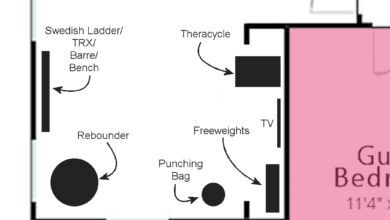Even if you didn’t get any snow, winter can do a number on your home. Once the cold weather tapers off and the ground starts to soften, it’s time to get out there and set things up for spring. Oh, and we’re not talking about superficial tidying up, btw. Keeping a list of yearly maintenance check-ins not only makes your house and outdoor spaces look good: It helps prevent larger (and more expensive) home repairs down the line—a win-win.
Check out our list of pre-spring must-dos below, jump on these tasks now, and cruise into spring and summer without a sweat.
1
Update Your Gutters
When leaves and debris build up in your gutters over the cold months, it can cause trouble. It creates a breeding ground for rodents and pests, but that’s honestly the least of it. Overflows and water buildup caused by overstuffed drainage can lead to interior and exterior damage that could cost thousands in repairs. Instead, replace old-school gutters with a seamless, LeafGuard Gutter one-piece system designed to help prevent all of the above. The brand is so confident in their Good Housekeeping Seal-vetted gutters that if they somehow clog, they guarantee they’ll come and clean them for free.
2
Scrub the Siding
Dirt, grime, mold, and mildew build up on your siding over time, particularly when the weather is wet. Yes, it’s a bad look but more than that, it can eat away at the very stuff meant to protect your house. To prevent that problem, clean siding at least once a year. For both wood or vinyl, use a non-bleach cleaner with a bristle brush. Start from the top and work down to keep dirt from running into already cleaned sections.
3
Shore Up the Roof
Losing a shingle here and there might not seem like a big deal, but even one gap could allow water to make its way into your home. If left exposed for too long, it seeps under the remaining shingles and rots them away or, worse, works through your ceiling and straight through to the interior. For this, it’s best to keep spare shingles that match on hand to give to your handyman for quick repairs so everything looks uniform while they up potentially harmful gaps.
4
Give the Furniture a Once-Over
Outdoor furniture can be tough, but it isn’t indestructible. Start the season by making sure your all-weather pieces—whether they’re wood or metal—survived storage. From there, scrub away any dirt and dust. Thankfully they are all relatively easy to clean with a bristle brush and a combo of warm water and dish soap. Let them dry completely to prevent rusting or rot—then take a seat.
5
Make Your (Flower) Bed
Before it’s warm enough to plant, remove dead leaves, plants, and sticks from your flower beds. First gently rake them out, then use a shovel to work organic compost into the top layer and any holes that opened up during the wet months. Do the same with your flower plots and wooden planters. It’s also an ideal time to take stock of where you have room to add new varietals, since plants are dormant or at their puniest now. Mark where perennial bulbs are planted to avoid accidentally digging them up.
6
Check the Decks
And inspect the patios too for that matter. Catching and replacing loose boards, pavers, or rotting wood or metal railings is easier than leaving them be and then having to have a contractor come out in a few years and replace the whole thing (and preventing tripping hazards.) Nailing in a new piece of wood stained to match or securing a loose patio stone with polymeric sand are little fixes that can go a long way to keeping it all level and safe.
7
Screen the Screens
Did you leave the removable screens for windows and doors in all winter? Forget to clean them before you put them away? It’s fine. Just use a vacuum with a soft bristle attachment to get off any loose dirt or pollen. For more stubborn gunk, gently rinse with a hose and scrub with a soft bristle brush and a combination of warm water and an all-purpose cleaner. Prop the screens up vertically to help them dry faster.
8
Tool Time!
Take inventory of all of your essentials. Is your hose in proper working order, are your shovels and metal tools clear of rust, do you have all of the gardening supplies you need? Buying replacement items you might need early can save you money. But before you spend on new metal tools to replace rusty ones, try cleaning with a remover like oxalic acid (use according to instructions) to get them back in shape and safe to use.
9
Lighten Up
Remove cobwebs and clean glass covers surrounding any outdoor light fixtures. Also, be sure to check that your bulbs are in proper working order. When possible, replace outdated bulbs with longer-lasting LEDs—it may save you money in the long run and means you may not have to replace them for years.
Caylin Harris
Caylin Harris is an Emmy-nominated producer, writer, crafter, stylist, and branded content creator.
This content is created and maintained by a third party, and imported onto this page to help users provide their email addresses. You may be able to find more information about this and similar content at piano.io







